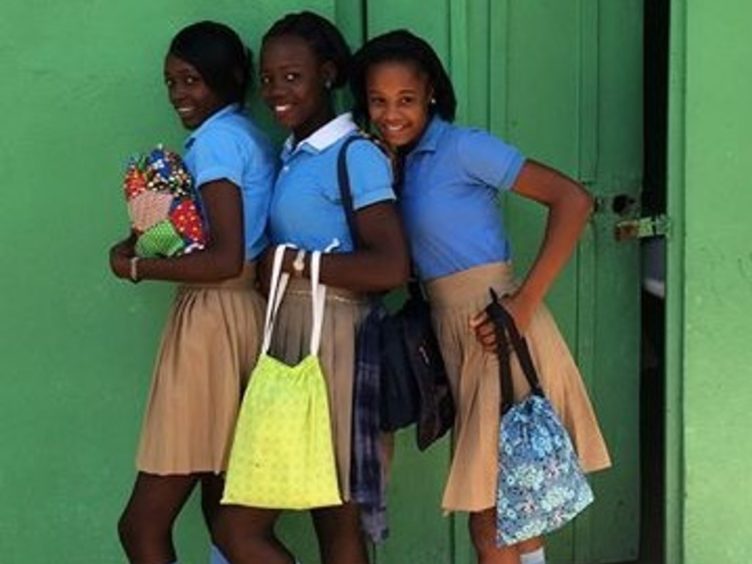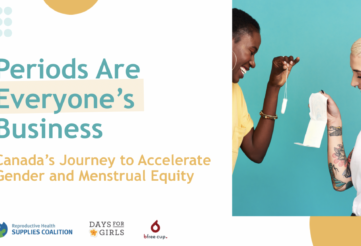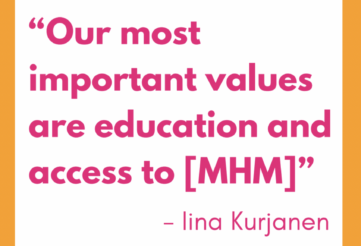What Can You Learn From a Pad?

Why Pads are a Big Deal
Special thanks to Your Mark on the World host Devin Thorpe for including Days for Girls in his conversation this week! Devin's show has featured #1 Bestselling Author Tony Robbins, Hall of Fame Quarterback Steve Young, billionaires Jean Case and Shari Arison, CEOs from companies like Overstock.com, HSNi, RBC Wealth Management and Hyundai USA, and celebrities like Tippi Hedren and Archie Panjabi. We look forward to adding you to the roster. You can watch his interview with Days for Girls' Founder and Executive Director Celeste Mergens here:
Here are the links:
YourMarkOnTheWorld.com: http://bit.ly/296yk9I
YouTube: http://www.youtube.com/watch?v=LzZnKFcuYZE
And then you may feel inspired to read the rest of Celeste's article accompanying the interview about how Days for Girls is proving small effective actions can change the world:
5 Keys to Reversing Cycles of Poverty
Since launching in 2008, Days for Girls has come a long way. Here are our top 5 lessons learned, which we hope will be helpful for any group seeking to better understand ways that simple solutions can make a big difference in addressing the roots of poverty.
1) Seek the Wisdom of Those You Serve
When Days for Girls began, I had been actively seeking ways to reverse poverty, applying them in Kenya. From solar water pumps, to efficient rocket stoves, poultry ventures and tilapia fish ponds, I was looking for effective innovations; researching, applying and documenting solutions. You can imagine my surprise when it came to me to ask what the girls were doing for feminine hygiene and then learning that they had nothing, they would just sit in their room for days. How? By sitting on a piece of cardboard, missing school in isolation. My first idea? A typical Western solution, disposable pads. However, I knew that even if I could consistently fundraise for hygiene supplies for 500 girls, that wasn't a sustainable solution, and would simply add to the trash burden (or create the need for them to spend more money on kerosene to incinerate the used products). Additionally, if I just sent money, they would use it to buy food. Any of us would. Anywhere that a family has to choose between food and hygiene, they will choose food. However, this doesn't solve the problem of addressing the many days of school, work, and opportunity that are missed when women and girls don't have pads. This is as true for the US as it is anywhere else in the world. What do homeless women do? What does a vulnerable teen do? Food stamps can't be used to purchase pads.
So we made our first washable pads for girls in Kenya. I can honestly say they were awful, but very few groups were talking about the need for feminine hygiene at the time – this was an issue just coming to the forefront, so we didn't have a lot to go on. We made the first pads white, because sanitary items are white. And they were shaped like pads, because they were pads. However, I soon learned that was not what worked best for the girls. Taboo and stigma made that design hard to care for properly. It wasn’t until we delivered the solution with education and a conversation about women’s health that the first girls explained the real difference that washable pads would make for them: they explained that previously they were able to get disposable pads from a staff member's office…if they were willing to sleep with him in return. While this is one story, that connection between menstruation and vulnerability echoed for millions all over the world. When we're ashamed to talk about something, when there is silence shrouding an issue, a lot can happen behind closed doors. That’s the moment that Days for Girls was born for me. The girls needed a solution that worked.
By asking for and responding to their feed back we were able to innovate a solution that washes with very little water and dries quickly, all without looking like a pad. All this is important for girls and women to be able to take care of themselves in many different settings. Days for Girls Kits are made of cloth and a waterproof material. They wash with less water and dry faster than other washable options. Each kit lasts 2-4 years. The DfG Kit has gone through 27 iterations, each one created by seeking the wisdom of those we serve. In fact, the design is nothing short of genius, because it was created by women and girls across the world. What if we hadn’t listened?
Since 2008, Days for Girls has reached over 300,000 women and girls, earning back collectively 54 million days of education and opportunity that would otherwise be missed without hygiene solutions. And we have reached 101 nations. That’s how big the need is, and the need was not even recognizing in international development until just a few years ago. This is a need that is keeping girls from school and women from work, creating isolation, indignity, exploitation and lost opportunity, not only for women and girls but for entire communities all over the world. Simple things matter. But the best solutions are developed by working with and seeking the wisdom of those you serve.
2) Be Culturally, Physically and Environmentally Relevant
Some solutions sound great at home, but apply them in another part of the world without context of their circumstances, and suddenly the solution can be ineffective or even absurd.
With Days for Girls, the disposables we provided at that very first school seemed like a good stopgap solution for the girls, but what about the next month? And when we arrived 3 weeks later we saw that the “disposables” were piled against posts nearby and the pit latrines were stopped up with them. The disposables littered every chink of the chain link fencing adjacent to the latrines. Some girls were even attempting to reuse those that had been left behind. There was no good place to dispose of them. They needed a solution that they could count on month after month, but not just any washable solution. They needed one that washed with very little water and dried quickly. It also needed to come with education, that ensured proper care and that usage was clear, so that the pads lasted. Our go to solution wasn’t appropriate for them. And perhaps it isn’t even the best solution for any of us. Perhaps we have more to learn from them in that regard.
Conversely, I was once at a development meeting with another nonprofit when an Executive Director proposed diverting funding for a composting toilet facility to instead build a 30 foot building for girls in the community school to shower…. in a drought stricken part of Kenya. It didn’t matter to her that they had so little water. It didn’t matter to her that the cost was greater than multiple classrooms. Nor that she was proposing importing one of the worst experiences of Junior High. To her it was a familiar solution from home that seemed like a good idea.
Development that ignores the realities of those served is not only ineffective but can be harmful. While solutions that are culturally, physically and environmentally relevant can be game-changers.
3) Look closer
I had been visiting that first orphanage and school and bringing support every six months for almost 2 years trying to help kids stay in school. Food, exam fees, books and more. It never occurred to me that lack of hygiene resources could be a reason for girls to be missing school. To give you an idea of the global level of need, UNESCO estimates that in Kenya alone, 2.6 million school girls are going without access to pads.
If you had asked me 7 years ago if menstrual hygiene management was one of the keys to keeping girls in school, reversing cycles of poverty, reducing violence in communities and introducing general health conversations, I don’t think I would have believed it. But it is. It was a tremendous need hidden in stigma and shame; no one wanted to talk about it, let alone consider it. And it was only because we listened that we learned the many costs women and girls pay when they don't have what they need for a basic biological function that half of the world’s population faces. Today more and more are talking about it. In fact, NPR named 2015 The Year of the Period. But until recently when people asked what was holding girls back, menstruation was the last thing anyone would name.
What other keys might we be missing? Looking a little deeper, especially in liminal, quiet spaces, can mean catching vital information.
4) Prioritize basic, direct, and effective, over efficient, big, and dazzling.
One of my favorite books is Cradle to Cradle. It’s a book documenting the
unique approach to design and science, created by architect William McDonough and chemist Dr. Michael Braungart. In their then-groundbreaking book they explained that effective is better than efficient. In our industrialized solution-driven world we are always looking for faster, stronger, brighter. They use the example of a cherry tree. By definition of industrial efficiency, there are excessive blossoms, too many limbs; there could be a few fewer leaves and it would still be an efficient cherry tree. But when considering effectiveness, those limbs provide shelter for birds, and those “extra” blossoms self-fertilize the tree, not to mention general appeal. Efficiency is not the same as effectiveness. High cost and complication does not equate to effectiveness. In fact, keeping things simple is often harder to do. Keeping things sustainable, community-led, and simple… that’s incredibly hard. But that's what is possible when you invite the wisdom of those you serve, and stay tenaciously flexible (yes, we're officially coining that as a thing) to respond with sensitivity to their needs in the most direct, basic and effective way possible.
5) Community-led Development
Days for Girls gets Kits into the world through a unique hybrid approach. The first half is our volunteer model, made up of over 600 chapters and teams in 17 nations that make and distribute Kits for free. The other half is our social enterprise model, where Kits are made in the same area where they are also sold. This combination is pretty unusual in the development world, but there are great reasons to bring both of these approaches together.
Our volunteer chapters are all self-funded, which has enabled DfG to have an extraordinary global impact on a shoestring budget. Furthermore, not only is this community-driven model incredibly cost-effective, but it also enables DfG to gather data all over the world, both in terms of the current level of need, as well as the long-term impact of Days for Girls Kits.
DfG Kits have a tremendous social and economic impact, not only in terms of school days earned back, but also because of the conversations they start. Our social enterprise arm teaches women to make their own Days for Girls Kits and to serve as Ambassadors of Women's Health Education within their own communities. By having not only the knowledge but also the supply chain, important social enterprise options then emerge for local women to lead the way in health, while providing Days for Girls Kits made within their own communities. It's how we are reaching the last mile in our goal of reaching ‘Every girl. Everywhere. Period.' It's working. For more information visit www.DaysforGirls.org









